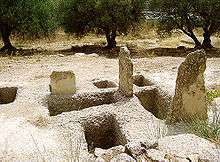Phourni

Phourni (Greek: Φουρνί, also Fourni) is the archaeological site of an ancient Minoan cemetery in Crete. Phourni is Greek for "furnace, oven" and the name of the hill on which the cemetery is located.
Geography
Phourni can be seen from Mount Juktas. It is a small hill situated northwest of Archanes, between Archanes and Kato Archanes. Phourni is reachable from a signed scenic path that starts at Archanes.
Archaeology
Excavations began at Phourni in 1964 by Efi and Yannis Sakellarakis and have continued until at least 1995.
The cemetery at Phourni was in use from Early Minoan II to Late Minoan IIIC - over one thousand years.
A tholos tomb first discovered in 1965 dates to 14th century BCE and shares a ground plan with tholos tombs at Mycenae and Orchomenus. Early Minoan tholos tombs and ossuaries have been excavated in the south part of the cemetery.
Finds include a dismembered corpse of a sacrificed horse, a bull's skull, a gold ring from a burial with a cultic scene engraved on it, knives, lead weights from a scale, 46 loom weights, a wine press, a libation table, bell-shaped figurines, approximately 250 cups, Early Minoan II seals, an Egyptian diorite vase, ivory seals and amulets and a pillar crypt. The bodies of two women found in a Late Minoan tholos tomb are of almost certain royal or religious importance due to the wealth of objects and the unusual sacrifices of a horse and a bull made to the chambers.
More than twenty buildings and tombs have been excavated at Phourni.
Finds excavated from Phourni are at the Heraklion Archaeological Museum.
References
- Swindale, Ian http://www.minoancrete.com/phourni.htm Retrieved 4 February 2006
Further reading
- Sakellarakis, J. and E. Crete, Archanes ISBN 960-213-234-5 (Guidebook)
- Myers, J.W., Myers, E.E. and Cadogan, G. "Archanes-Phourni" The Aerial Atlas of Ancient Crete ISBN 978-0-520-07382-1
External links
| Wikimedia Commons has media related to Phourni. |
Coordinates: 35°14′46″N 25°09′31″E / 35.24611°N 25.15861°E